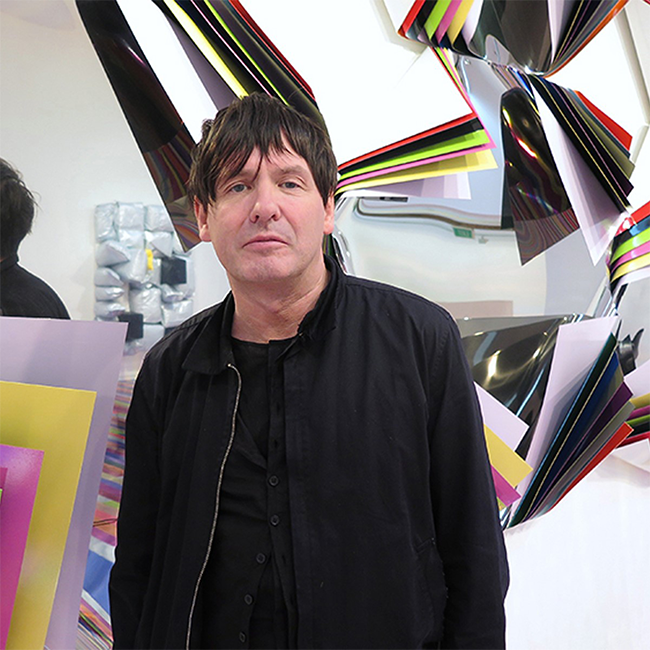Jim Lambie
Jim Lambie was born 1964 in Glasgow, Scotland and graduated from the Glasgow School of Art in 1994. Lambie lives and works in Glasgow, as a visual artist, musician and DJ.
Lambie specialises in colourful sculptural installations made from everyday modern materials including pop culture objects, such as posters and album covers, and household accessories. Lambie’s practice evolves from a response to the psychology of space and colour, utilising the two in a way that is deeply rooted in colour theory, and draws parallels with the concept of synesthesia, where the senses are combined. Lambie is also deeply influenced by movements in art and the history of place. His work specifically relates to the industrial past of his hometown of Glasgow, and utopian liberation movements, such as William Morris’ Socialism and the Arts and Crafts movement.
His installations are usually site-specific, using existing architecture as inspiration. For his trademark floor installations, he uses brightly coloured vinyl tape arranged into patterns around the floor, tracing the shape of the room to reveal the idiosyncrasies of its architecture. The vinyl tape, an everyday material applied in continuous lines, has a capacity to transform the dynamics of space, changing a quiet gallery space into an energetic and emotional space of sensory pleasure. Lambie creates a rhythm that vibrates and pulsates, and even confuses and disorients the spectator.
Encapsulating ideologies in art history, Lambie allows himself to work liberally and outside the constraints of a single medium or dimension. His installations reinvent the space into a dazzling interaction of colours, shapes and forms, challenging the viewer’s perceptions and creating an elaborate, otherworldly experience.

Jim Lambie was born 1964 in Glasgow, Scotland and graduated from the Glasgow School of Art in 1994. Lambie lives and works in Glasgow, as a visual artist, musician and DJ.
Lambie specialises in colourful sculptural installations made from everyday modern materials including pop culture objects, such as posters and album covers, and household accessories. Lambie’s practice evolves from a response to the psychology of space and colour, utilising the two in a way that is deeply rooted in colour theory, and draws parallels with the concept of synesthesia, where the senses are combined. Lambie is also deeply influenced by movements in art and the history of place. His work specifically relates to the industrial past of his hometown of Glasgow, and utopian liberation movements, such as William Morris’ Socialism and the Arts and Crafts movement.
His installations are usually site-specific, using existing architecture as inspiration. For his trademark floor installations, he uses brightly coloured vinyl tape arranged into patterns around the floor, tracing the shape of the room to reveal the idiosyncrasies of its architecture. The vinyl tape, an everyday material applied in continuous lines, has a capacity to transform the dynamics of space, changing a quiet gallery space into an energetic and emotional space of sensory pleasure. Lambie creates a rhythm that vibrates and pulsates, and even confuses and disorients the spectator.
Encapsulating ideologies in art history, Lambie allows himself to work liberally and outside the constraints of a single medium or dimension. His installations reinvent the space into a dazzling interaction of colours, shapes and forms, challenging the viewer’s perceptions and creating an elaborate, otherworldly experience.
